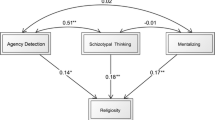Abstract
L.B. Brown's model of religious faith posits two bipolar religious orientations (intrinsic-extrinsic and autonomy-observance) that represent a two-dimensional space in which a religious believer can be located. This paper proposes a developmental sequence within Brown's model. The psychometric tradition of religious orientations is combined with a developmental tradition. The developmental process is consistent with models by A. Maslow, L. Kohlberg, J. Fowler, and J. Loevinger. Religious faith typically springs from extrinsic motivations. Most religious adherents achieve the next level, “observance,” or identification with a religious community and its creeds. Some progress to intrinsic religiousness, and fewer attain religious autonomy.
Similar content being viewed by others
References
Brown, L.B., “Classifications of Religious Orientation,”J. Scientific Study of Religion, 1964,4, 91–99.
—, “A Study of Religious Belief,”British J. Psychology, 1962,53, 259–272.
E.g., Allport, G.W., and Ross, J.M., “Personal Religious Orientation and Prejudice,”J. Personality and Social Psychology, 1967,5, 432–443; Hoge, D.R., “A Validated Intrinsic Religious Motivation Scale,”J. Scientific Study of Religion, 1972,11, 369–376.
Fleck, J.R., “Dimensions of Personal Religion: A Dichotomy or Trichotomy?” In Donaldson, W.J., Jr., ed.,Research in Mental Health and Religious Behavior. Atlanta, Psychological Studies Institute, 1976. See also Allen, R.O., and Spilka, B., “Committed and Consensual Religion: A Specification of Religious Prejudice Relationships,”J. Scientific Study of Religion, 1967,6, 191–206.
Batson, C.D., “Religion as Prosocial: Agent or Double Agent?”loc. cit., 1976,15, 29–45.
Meadow, M.J., “The Structure of Religious Attitudes: A Factor Analytic Study,” Ph.D. Dissertation, University of Minnesota, 1976.
Kahoe, R.D., and Meadow, M.J., “Religious Orientation Dimensions: Individual and Institutional Interrelations.” Paper read at the Society for the Scientific Study of Religion, Chicago, October, 1977.
Brown, “Classifications of Religious Orientation,”loc. cit..
E.g., Rokeach, M.,The Open and Closed Mind. New York, Basic Books, 1960; Wilson, G.D.,The Psychology of Conservatism. New York, Academic Press, 1973.
Rokeach,op. cit., E.g., p. 67.
Batson,op. cit.; “Religion as Prosocial: Agent or Double Agent?”loc. cit., 1976,15, 29–45.; Kahoe and Meadow,op. cit.; Kahoe, R.D., “The Psychology and Theology of Sexism,”J. Psychology and Theology, 1974,2, 284–290.
Kahoe, R.D., “Personality and Achievement Correlates of Intrinsic and Extrinsic Religious Orientations,”J. Personality and Social Psychology, 1974,29, 812–818; Kahoe, R.D., and Dunn, R.F., “The Fear of Death and Religious Attitudes and Behavior,”J. Scientific Study of Religion, 1975,14, 379–382; Thompson, A., “Openmindedness and Indiscriminate Antireligious Orientation,”loc. cit., 1974,13, 471–477.
Kahoe, “Personality and Achievement Correlates of Intrinsic and Extrinsic Religious Orientations”op. cit..
Kahoe and Meadow,op. cit. “Religious Orientation Dimensions: Individual and Institutional Interrelations.” Paper read at the Society for the Scientific Study of Religion, Chicago, October, 1977.
Allport, G.W., “The Individual and His Religion. New York. Macmillan, 1950, p. 71.
Maslow, A., “A Theory of Human Motivation”,Psychological Review, 1943,50, 370–396.
—,The Farther Reaches of Human Nature. New York, Viking, 1971.
Kohlberg, L., “The Child as a Moral Philosopher,”Psychology Today, September, 1968, 25–30.
See Berryman, J.W., ed.,Life Maps: Conversations on the Journey of Faith, Waco, Texas, Word Books, 1977.
Loevinger, J., “The Meaning and Measurement of Ego Development,”American Psychologist,” 1966,21, 195–206; —Ego Development, San Francisco, Jossey-Bass, 1976.
Kohlberg,op. cit. “The Child as a Moral Philosopher,”Psychology Today, September, 1968, 25–30.
Allport and Ross,op. cit.“.
E.g., Batson,op. cit. “Religion as Prosocial: Agent or Double Agent?”loc. cit., 1976,15, 29–45.
Brown, “Classifications of Religious Orientation,”op. cit., p. 96.
Author information
Authors and Affiliations
Rights and permissions
About this article
Cite this article
Kahoe, R.D., Meadow, M.J. A developmental perspective on religious orientation dimensions. J Relig Health 20, 8–17 (1981). https://doi.org/10.1007/BF01533283
Issue Date:
DOI: https://doi.org/10.1007/BF01533283




